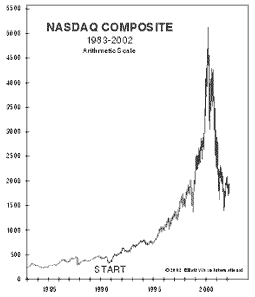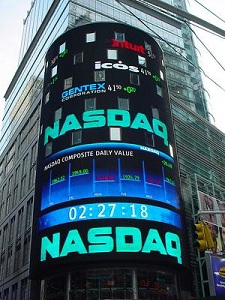By Jesse Colombo (This article was written on August 19th, 2012)
The Dot-com Bubble or the Tech Bubble was a speculative bubble in the shares of early internet companies called “Dot-coms.”
Soon after the 1987 stock market crash, global stock markets resumed their previous bull market trend, led by computer and other technology-related stocks that were traded on the new electronic NASDAQ stock exchange.
 By the early 1990s, personal computers were becoming increasingly common for both business and personal use. Now that computers were finally becoming reasonably priced and relatively user-friendly, they were no longer relegated to being the domain of geeky hobbyists.
By the early 1990s, personal computers were becoming increasingly common for both business and personal use. Now that computers were finally becoming reasonably priced and relatively user-friendly, they were no longer relegated to being the domain of geeky hobbyists.
Personal computers had become genuinely useful business tools that granted their users a significant boost in productivity. Business applications were invented to help users with a variety of tasks from accounting to tax preparation to word processing. Computers also began to compete with television as a form of entertainment as PC video games entered the marketplace. The operating system company Microsoft prospered enormously as almost every computer system sold had their software installed on it.
During the 1990s, the U.S. computer industry decided to focus primarily upon computer software development instead of designing and manufacturing computer hardware. The reason for this focus was because computer software was a product with very high profit margins, unlike computer hardware. Software companies generated profits by selling licensed software, which costs very little to reproduce. Computer hardware, however, was rapidly becoming a commodity product or a product that is virtually indistinguishable from the product of any other competitor, which forces companies that are manufacturing such products to strongly compete on price. Asian companies, with their low manufacturing costs, produced virtually all computer hardware components by the 1990s. Software, however, was protected as intellectual property with patents, which created a strong barrier to entry – a benefit that is highly sought after in business.
Software companies’ stocks were very strong performers throughout the 1990s. Enthusiasm over the software business led to the creation of many small software startups, with a good portion of these fledgling companies being launched by college students in garages, paying their employees in as much pizza and soda as they desired. Practically every software startup hoped to become “the Next Microsoft”.
 Eventually, many of these startup companies attracted the attention of venture capitalists who were interested in financing the startups, taking them public and, hopefully, reaping massive profits. By this point, startups began to pay their employees with company shares with the intention that the shares would become very valuable when company eventually went public. The majority of the software companies that were started during this era were located in Silicon Valley, near San Francisco, which became a technology Mecca. PCs became even more popular in the mid-1990s, when blockbuster PC games such as Sim City and Duke Nukem were launched and inspired many young people to become tech savvy.
Eventually, many of these startup companies attracted the attention of venture capitalists who were interested in financing the startups, taking them public and, hopefully, reaping massive profits. By this point, startups began to pay their employees with company shares with the intention that the shares would become very valuable when company eventually went public. The majority of the software companies that were started during this era were located in Silicon Valley, near San Francisco, which became a technology Mecca. PCs became even more popular in the mid-1990s, when blockbuster PC games such as Sim City and Duke Nukem were launched and inspired many young people to become tech savvy.
By the mid-1990s, the NASDAQ index of technology stocks was rising at an extremely fast pace, causing many tech-focused investors to become wealthy.
By 1994, the internet first became available to the general public. A primitive form of the internet called DARPANet had been around since 1969 and was created by government agencies as an efficient way to exchange scientific and military information to computers in different locations. During the mid-1990s, the internet had evolved as a way for people to communicate via email, use chat rooms and browse websites.
Almost immediately, businesses saw the internet as a significant profit opportunity. America Online (AOL) made the internet available to the general public on a large scale. The Yahoo! search engine and internet portal was started in 1994 as a directory of websites. The retailer Amazon.com became the first online book retailer in 1994. EBay was started in 1995 as an online auction site. As the internet became increasingly commercialized, many online businesses and their founders grew fantastically wealthy. Technology stocks continued to soar and created a very strong incentive for more technology companies to become publicly traded. Many early tech company shareholders, including employees, became millionaires overnight when their companies IPOd. Tech companies continued to pay their employees in stock options, which profited greatly as long as stocks maintained their strong upward trajectory. By the late 1990s, even some tech company secretaries had option portfolios valued in the millions, while several companies offered BMWs as a sign-on bonus for new employees! This was clearly an example of irrational exuberance.
as an online auction site. As the internet became increasingly commercialized, many online businesses and their founders grew fantastically wealthy. Technology stocks continued to soar and created a very strong incentive for more technology companies to become publicly traded. Many early tech company shareholders, including employees, became millionaires overnight when their companies IPOd. Tech companies continued to pay their employees in stock options, which profited greatly as long as stocks maintained their strong upward trajectory. By the late 1990s, even some tech company secretaries had option portfolios valued in the millions, while several companies offered BMWs as a sign-on bonus for new employees! This was clearly an example of irrational exuberance.
The booming economy and stock market of the late 1990s inspired some economists to speculate that we were in a “New Economy” in which inflation was virtually nonexistent and where recessions were a relic of the past. According to this logic, the “Old Economy” represented traditional brick-and-morter businesses, which included sectors such as natural resources and retail stores. Some analysts even believed that corporate earnings and other financial data were not relevent for analyzing and investing in technology and internet-related stocks.
From 1996 to 2000, the NASDAQ stock index exploded from 600 to 5,000 points. “Dot-com” companies run by people who were barely out of college were going public and raising  hundreds of millions of dollars of capital. Many of these companies lacked clear business plans and even more had no earnings whatsoever to speak of. For example, Pets.com, which had intended to become an online pet products retailer, was losing money before it went public and raised billions of dollars. Numerous dot-com companies wasted millions of dollars on frivolous parties to celebrate their IPOs. There are even stories of dot-com employees who walked around their offices barefoot and played foosball and video games during the work day. At the peak of the dot-com bubble in 1999, it was said that a new millionaire was created every 60 seconds in Silicon Valley.
hundreds of millions of dollars of capital. Many of these companies lacked clear business plans and even more had no earnings whatsoever to speak of. For example, Pets.com, which had intended to become an online pet products retailer, was losing money before it went public and raised billions of dollars. Numerous dot-com companies wasted millions of dollars on frivolous parties to celebrate their IPOs. There are even stories of dot-com employees who walked around their offices barefoot and played foosball and video games during the work day. At the peak of the dot-com bubble in 1999, it was said that a new millionaire was created every 60 seconds in Silicon Valley.
By early 2000, reality started to sink in. Investors soon realized that the dot-com dream had devolved into a classic speculative bubble. Within months, the NASDAQ stock index crashed from 5,000 to 2,000. Hundreds of stocks such as Pet.com, which once had multi-billion dollar market capitalizations, were off the map as quickly as they appeared. Panic selling ensued as the stock market’s value plunged by trillions of  dollars. The NASDAQ further plunged to 800 by 2002. One former high-flier, Microstrategy, slid from a lofty $3500 per share to a pitiful $4 per share. At this time, numerous accounting scandals came to light in which tech companies had artificially inflated their earnings. In 2001, the U.S. economy experienced a post dot-com bubble recession, which forced the Federal Reserve to repeatedly cut interest rates to stop the bleeding. Hundreds of thousands of technology professionals lost their jobs and, if they had invested in tech stocks, lost a significant portion of their life savings.
dollars. The NASDAQ further plunged to 800 by 2002. One former high-flier, Microstrategy, slid from a lofty $3500 per share to a pitiful $4 per share. At this time, numerous accounting scandals came to light in which tech companies had artificially inflated their earnings. In 2001, the U.S. economy experienced a post dot-com bubble recession, which forced the Federal Reserve to repeatedly cut interest rates to stop the bleeding. Hundreds of thousands of technology professionals lost their jobs and, if they had invested in tech stocks, lost a significant portion of their life savings.
Needless to say, the New Economy theory was proven wrong and traditional economic principles still hold. What is sadly interesting is how bubbles will continue to occur in the future. When they do occur, foolish investors will continue to convince themselves that “this time is different!”
Other Dot-com Bubble Resources:

